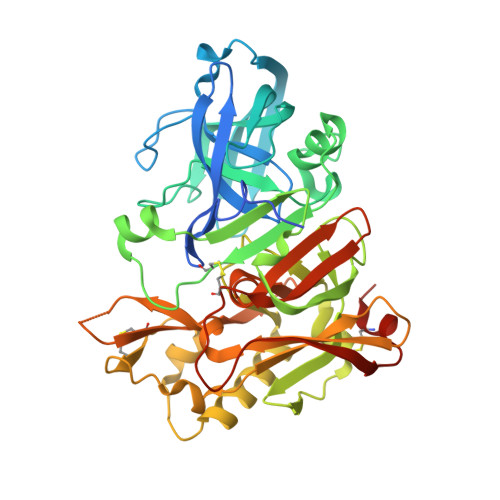Design and Validation of Bicyclic Iminopyrimidinones As Beta Amyloid Cleaving Enzyme-1 (BACE1) Inhibitors: Conformational Constraint to Favor a Bioactive Conformation.
Mandal, M., Zhu, Z., Cumming, J.N., Liu, X., Strickland, C., Mazzola, R.D., Caldwell, J.P., Leach, P., Grzelak, M., Hyde, L., Zhang, Q., Terracina, G., Zhang, L., Chen, X., Kuvelkar, R., Kennedy, M.E., Favreau, L., Cox, K., Orth, P., Buevich, A., Voigt, J., Wang, H., Kazakevich, I., McKittrick, B.A., Greenlee, W., Parker, E.M., Stamford, A.W.(2012) J Med Chem 55: 9331-9345
- PubMed: 22989333
- DOI: https://doi.org/10.1021/jm301039c
- Primary Citation of Related Structures:
4H1E, 4H3F, 4H3G, 4H3I, 4H3J, 4HA5 - PubMed Abstract:
On the basis of our observation that the biaryl substituent of iminopyrimidinone 7 must be in a pseudoaxial conformation to occupy the contiguous S1-S3 subsites of BACE1, we have designed a novel fused bicyclic iminopyrimidinone scaffold intended to favor this bioactive conformation. Strategic incorporation of a nitrogen atom in the new constrained ring allowed us to develop SAR around the S2' binding pocket and ultimately resulted in analogues with low nanomolar potency for BACE1. In particular, optimization of the prime side substituent led to major improvements in potency by displacement of two conserved water molecules from a region near S2'. Further optimization of the pharmacokinetic properties of this fused pyrrolidine series, in conjunction with facile access to a rat pharmacodynamic model, led to identification of compound 43, which is an orally active, brain penetrant inhibitor that reduces Aβ(40) in the plasma, CSF, and cortex of rats in a dose-dependent manner.
Organizational Affiliation:
Department of Medicinal Chemistry, Merck Research Laboratories, 2015 Galloping Hill Road, Kenilworth, New Jersey 07033, United States. mihirbaran.mandal@merck.com















